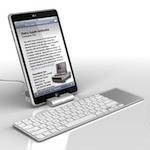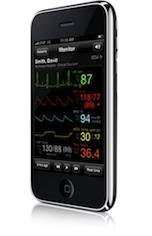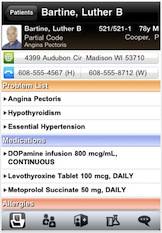Apple’s “iTablet” – whatever it may be – could be destined to transform our care delivery system in a major way. For years, key hardware vendors like Panasonic, Toshiba, HP and Intel have been working hard to embed tablet computers into hospitals.

The promise of improved clinical information systems, based on real-time information updates across patient touchpoints could be a workflow game changer. If the tablet becomes the tool that is carried with a nurse or doctor on their travels from patient to patient, it will save time, money and lives by enabling the first “always updated” system.
Unfulfilled Opportunity
Considering the massive expense of implementing an electronic health record (EHR) system – for example the $4 billion spent by Kaiser Permanente – data synchronization is a huge investment for the healthcare system. At the national level, the Office of National Coordinator (ONC) is administering billions of dollars of stimulus dollars to help systems move forward into the electronic realm.
But early today, the ONC’s Charles Friedman told a FDA interoperability meeting that in 2008, a mere 4% of systems in the United States qualify as “fully functional” electronic health record systems. With all the fantastic and innovative work that has gone into creating a healthcare specific devices, such as Panasonic’s series of tablet PCs, it’s not the mainstream yet.
A big part of this reason is usability of the software. Clearly, vendors have been building creative and durable machines. But in a similar way that earlier smartphones now seem clumsy compared to the iPhone, we haven’t yet seen a product that is amazing. Something like what we think the Apple tablet could be would change this landscape overnight and may be priced at a point that’s much less than other medical devices on the market.
Mobile Health Momentum
The iPhone has already changed the face of healthcare. Apple shared this fact at last year’s iPhone OS 3.0 release and within the keynote at WWDC. The momentum that started with consumer applications has moved to forward-looking doctors and health providers. We know that it is becoming common practice for some doctors and nurses to carry both their company-issued Blackberry and their personally purchased iPhone.
There are already amazing applications in the market. AirStrip allows doctors to monitor patient vital signs and receive alerts from afar. There are now personal health records that can be carried and updated from anywhere.

Additionally, there are information-rich applications that allow nurses, doctors and patients to look up health information in real time. Last week during the Haiti tragedy, an injured individual was able to use an iPhone to treat himself using an first aid application on the iPhone.
Clinician Ready
Apple and EPIC systems have been collaborating to release the first version of MyChartManager on the iPhone. EPIC is a leading provider of EHR in the United States, and powers systems such as Kaiser Permanente and Palo Alto Medical Foundation in the Bay Area, to name a few. The application, named Haiku was released on Jan. 13, 2010, and several health systems are in the process of testing it. It’s a clear contender for the “killer app” in the hospital setting. Looking at the screenshots, it’s clear that more screen real estate would be ideal – which means it may be just the right time for an iTablet-like device to emerge on the market.

It’s the Apps
It is nearly certain that iPhone OS 4.0 will create a path for existing applications to “upsize” to a tablet device, and this includes size. The medical category today is already the highest-aggregate-priced category on the App Store today, and with the promise of applications inside the clinical walls, the opportunity gets much larger.
The iPhone-to-tablet combination may be the biggest reason that a tablet is successful in the market, since the entire iPhone developer community will be able to deliver on this new platform. With Apple’s success in having an integrated OS that shares core libraries across both the Mac and iPhone, it is likely that a table device will also connect with apps from both the iPhone and the Mac.
Workflow Wish List
Having had the opportunity to observe clinical workflow and talk with several healthcare providers – including Kaiser Permanente and the Lucille Packard Children’s Hospital – we’ve compiled a list of device capabilities that would change healthcare. Our wishlist includes:
- Real-time observations, including vitals signs: It is amazing that many systems still require doctors or nurses to take down vitals on pencil and paper, even when an EHR is in place.
- Shift changes: Shift transitions between nurses can be greatly improved by having a device that is mobile and moves freely with each part of the staff, so that the shift exchange is a workflow generated process that isn’t tied to a physical location. Nurses move, the system should too.
- Rich content delivery: The ability to share with a patient what is going to happen in rich detail, including video, can be a major force in improving readiness of the patient.
- Video: Bringing remote feeds right into the emergency room, outpatient setting or other environment should be easier than ever before.
- Family and friends: Offering a feature for family and friends to directly communicate with the patient is a huge opportunity. A tablet may be the perfect device to enable more personal discussion and check-ins with family members in the hospital, near or far.
Prediction
If Apple does in fact show a tablet device at the Jan. 27 event, hospitals around the country will react with pilot programs, and we will see tablets and Macs join the iPhone in helping deliver healthcare with a new era of style and grace. It is also true that Apple will have an uphill battle getting past corporate IT; getting support in the enterprise as a new class of device is a daunting challenge. But the “iTablet” will give visionary IT leaders more opportunity to change the status quo and look to the future.
We can hear the doctor already: “Take two moments to fire up your iTablet, and teleconference me in the morning.”
What do you think, could a tablet be the product that brings Apple inside the hospital walls and improve the system?
Photo credit: Balazs Gal.










